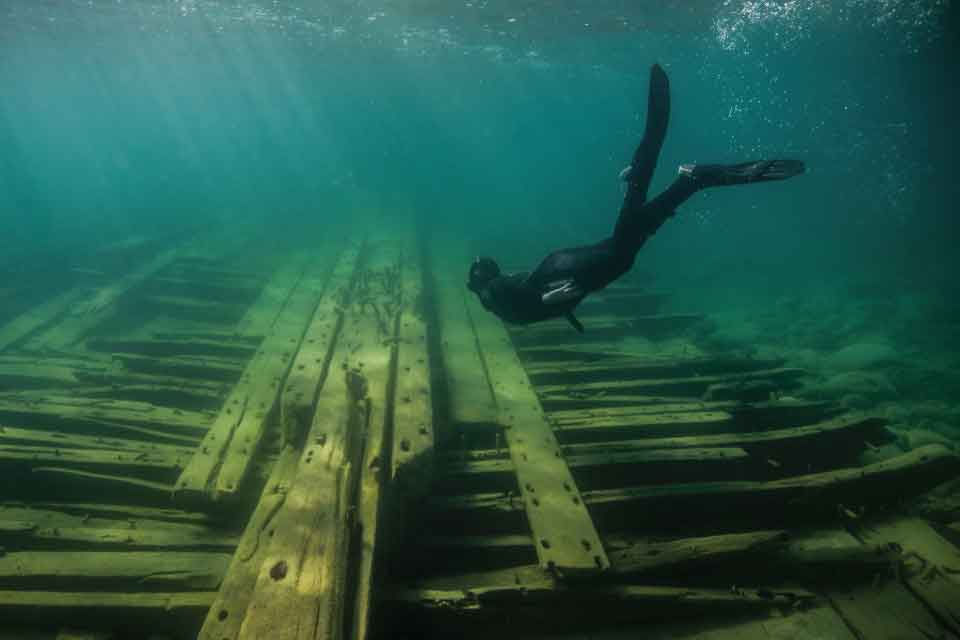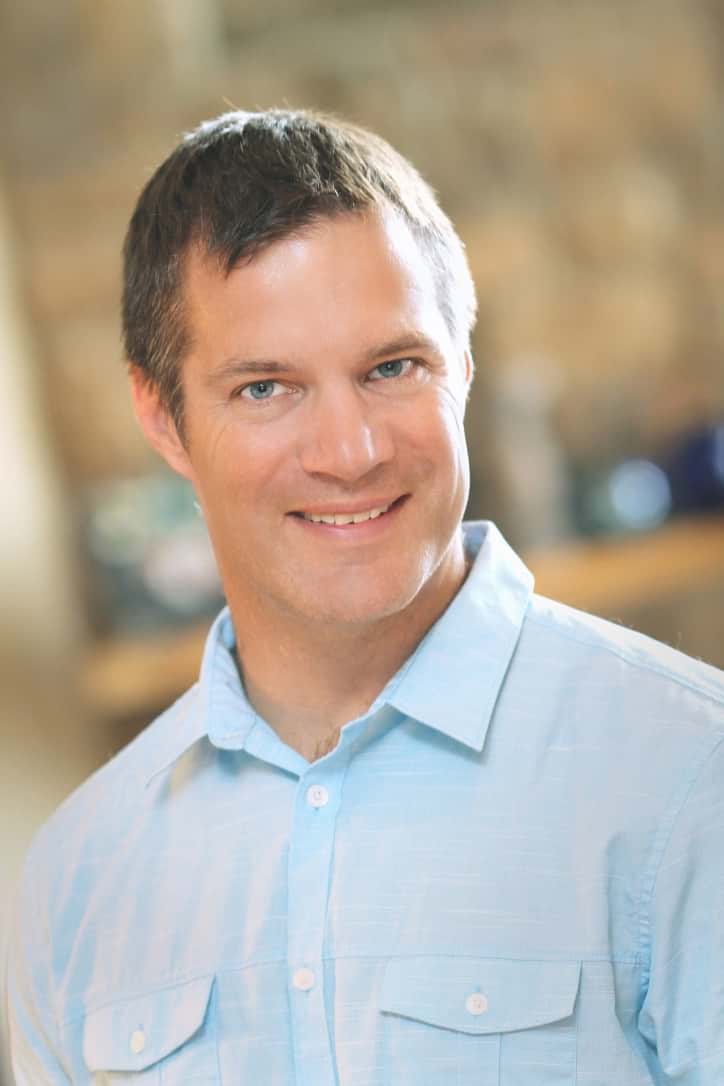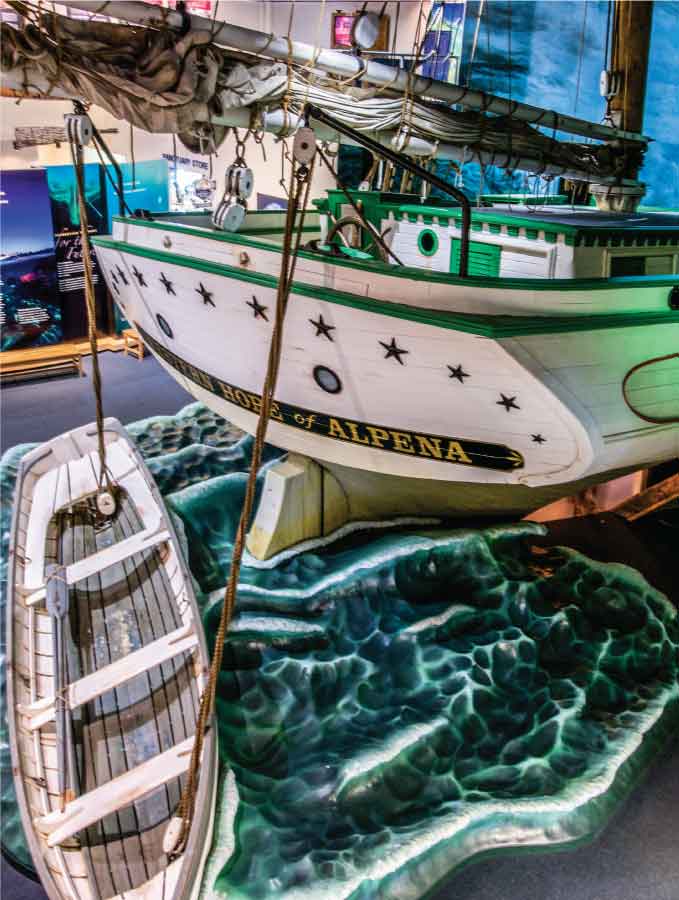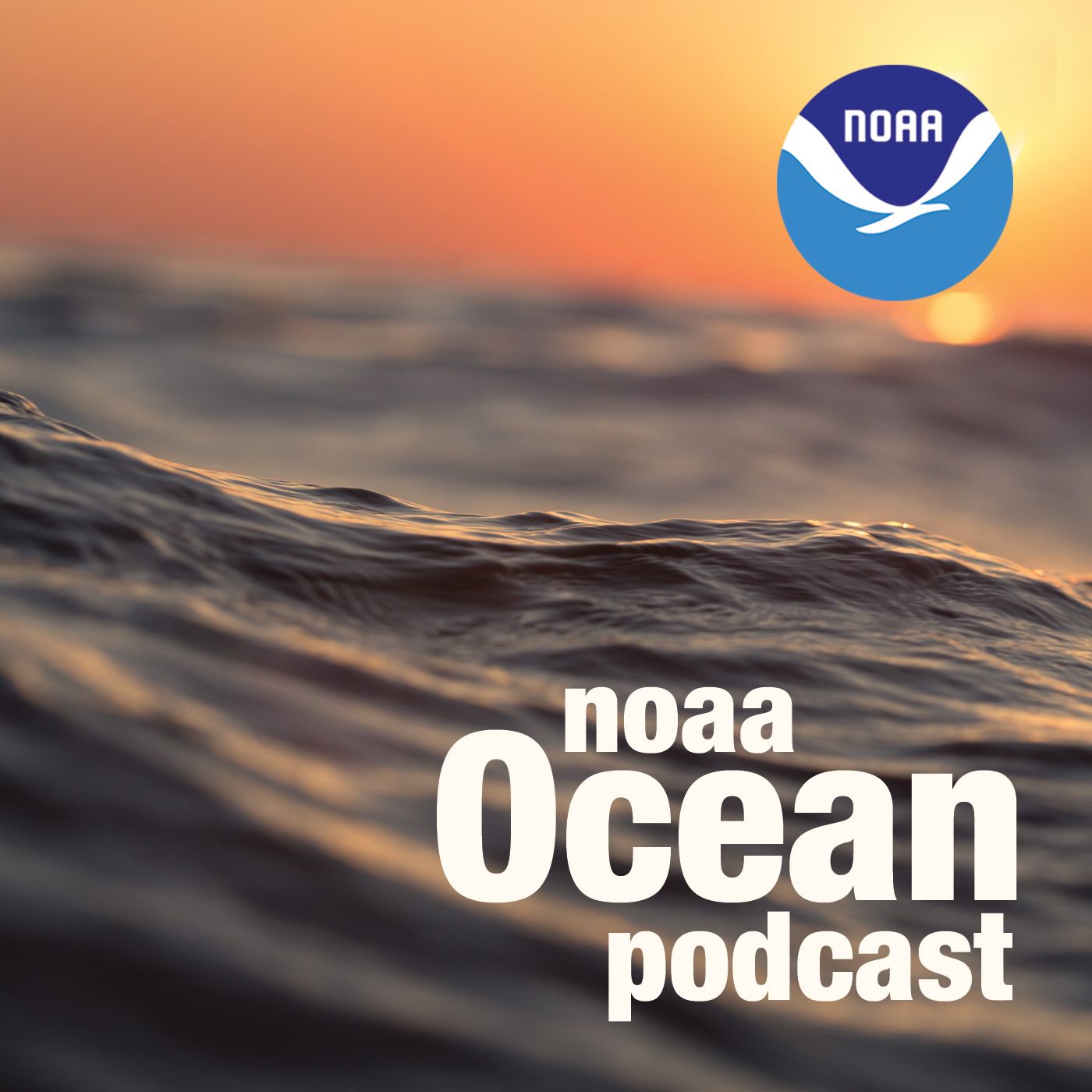Shipwrecks, Science, and Stewardship at Thunder Bay National Marine Sanctuary
NOAA Ocean Podcast: Episode 43
Northeast Michigan’s Thunder Bay National Marine Sanctuary is estimated to contain over 200 shipwrecks. In this episode, we speak with sanctuary superintendent Jeff Gray about the significance of these world-class wrecks, the rich history they contain, and the wealth of scientific research and recreational opportunities that the sanctuary has to offer. We also dive into how NOAA, its partners, and the community of Alpena, Michigan, work together to advance the sanctuary’s mission of preservation, research, and recreation.

A snorkeler explores the shallow site of the sunken schooner Portland, lost in a Lake Huron storm in 1877.
Transcript
HOST - This is the NOAA Ocean podcast. I’m Abby Reid.
Northeast Michigan’s Thunder Bay National Marine Sanctuary, located on Lake Huron — one of the five Great Lakes — is estimated to contain over 200 shipwrecks. Thunder Bay is near one of the most dangerous stretches of water in the Great Lakes system. Unpredictable weather, fog, sudden gales, and rocky shoals earned the area the name "Shipwreck Alley.”

Jeff Gray, Superintendent of Thunder Bay National Marine Sanctuary
These beautifully preserved shipwrecks, in addition to being the home of a wide variety of marine life, hold an important piece of our nation’s history, while also providing the public with some truly incredible recreational opportunities.
But there’s more to Thunder Bay’s story than these amazing shipwrecks.
NOAA's Office of National Marine Sanctuaries, the community of Alpena, Michigan, and NOAA partners, work closely together to carry out the sanctuary’s mission of research, protection, and recreation.
I spoke with Jeff Gray, superintendent of Thunder Bay National Marine Sanctuary, to find out more about this very special place. We were using a chat service on our laptops to record the interview, so the audio might fluctuate from time to time.
I invite you to sit back, relax, and learn all about the grandeur, history, and scientific research that lies within Thunder Bay.
Here’s Jeff.
JEFF GRAY: Hi, my name’s Jeff Gray, I’m the Superintendent of the Thunder Bay National Marine Sanctuary, and the sanctuary’s located up in Northern Michigan on Lake Huron. And it’s about 4,300 square miles marine protected area. And what makes us a nationally significant area is over 200 historic shipwrecks rest below the waves of Lake Huron, and our job is to try to protect these sites, while at the same time give people access to em.
HOST: Can you briefly share some information about Thunder Bay National Marine Sanctuary beyond what you just shared, and, what’s unique about it?
JEFF GRAY: Yeah well, what, what’s unique are this collection of shipwrecks, and like I said, there’s over 200 of them that we believe are out there, and the cold fresh water of Lake Huron has preserved these shipwrecks like no other place in the world. They’re really some of the best-preserved wrecks in the entire world. Some of them are literally ships sitting on the bottom with masts still standing in this unmatched preservation. Really it has great value to scientists and archaeologists to learn about the past, but they also are incredible incredible recreational assets, and it helps drive the economy up here. And so we can learn about the past, we can learn about the Great Lakes, but it’s driving the economy, the Blue Economy up in Northern Michigan.
We get researchers from around the world that come here to study these sites, and not just the archaeology and the shipwrecks themselves, but to study Lake Huron and the Great Lakes themselves. And it’s, it’s really what we’re doing here is we’re trying to protect the Great Lakes, and the rich history hidden below.
HOST: It’s not only archaeology, or only the ecology of the lakes, it runs the gamut.
JEFF GRAY: Yeah that. That’s true. What makes the sanctuary significant, nationally significant, internationally significant, is the collection of shipwrecks. But we use those shipwrecks really to engage people about the larger issues facing the Great Lakes.
You know, for those that haven’t been here, one of my favorite parts of my job is I get to meet people from around the world that it’s their first time coming to the Great Lakes, and they can’t fathom what a Great Lake is until they sit there and see it. And you know so many times when we take people to the shore for the first time and they say, ‘Wait, you can’t see across it.’
I mean, it’s, one fifth of the world’s fresh water is sitting here, and it’s, it’s such an incredible and important natural resource that we’re excited to be a part of the team that gets to work to protect it and share it with our local residents and the rest of the world.
HOST: Can you talk about some of the programs and recreational opportunities that Thunder Bay offers? And, are there other ways that visitors and the community can get involved?
JEFF GRAY: Yeah, that’s a great question. There’s multiple ways you can try to protect something, and one way you can do is you can put a fence around it, but that, that’s not what we do here. We have a program called Get in Your Sanctuary, which is a way we’re encouraging people to, to recreate in national marine sanctuaries and here in Thunder Bay and it’s either, you know, world class diving, snorkeling, kayaking, paddle boarding, there’s glass bottom boat that takes folks out there, there’s wrecks on the beach that you can go see, and so, we really really encourage people to go out and visit the sites but do so in a responsible way so the next generation can appreciate these, these treasures. These museums under the waves the same way that we do today.
Our belief 100% is that the best way to get someone to care about a resource is giving them access to it. And as they develop a connection to it, they’ll develop the the will, the public will to protect it and do more.
HOST: That makes a lot of sense. You know, having that tangible connection to something really, you care about it. And want to protect it, like you said. It’s great.

A display at Thunder Bay National Marine Sanctuary’s Great Lakes Maritime Heritage Center in downtown Alpena, Michigan.
JEFF GRAY: And you, you think of the wrecks, and it’s a way we can get, you know, from the youngest students you can imagine to senior groups, we can use these wrecks to get people to tell the story about the Great Lakes, tell the story about these ships. And then, you know, hopefully inspire them to take positive action to protect not just the Great Lakes, but the ocean and our overall environment.
HOST: So, when you and I spoke when we were just, you know, talking about the sanctuary, you were giving me some background, you mentioned the sanctuary’s origin story. And it’s a very interesting one. Can you talk about why the sanctuary was formed, and how the community has engaged with it over time?
JEFF GRAY: Yeah, well we were designated in the year 2000, so we’re celebrating our 20th year now, we’re excited about that, and it’s, much has happened over that time period. And the community has really embraced the sanctuary and its mission. And I use the word “we” a lot. And it does not just mean the NOAA employees at Thunder Bay. But it’s really our community and partners that work on this shared mission of resource protection and, and making our community a better place by doing that.
But it took over 10 years for the sanctuary to make it through the designation process. Part of that was it’s a very public process, we are community-based so the community gets a say, but there was great concern about what it would mean to have a federal agency, NOAA, coming in to the community and, there was opposition by commercial fishermen, recreational fishermen, some of the divers worried that they would not have the same access to the sites.
In fact, there was so much opposition, 70% of the voters voted against having a sanctuary. With time and negotiation, an acceptable agreement was made, and, but it kind of out a five year window on the sanctuary, and, after that five years, 2005, the governor held a series of public meetings up here around the state and the number one comment was not that people wanted to see the sanctuary go, but they wanted to see it expand significantly. And today we are almost ten times larger than we were when we started, and that’s because of this great connection to the community and our joint effort to protect these resources.
The fishermen, the divers, they’ve become by far our biggest allies. We work hand in hand. They love these sites as much as we do, they love the lakes as much as we do, and we work together as a community to figure out the best way to, to move our mission forward.
HOST: So, circling back to shipwrecks. As you mentioned, the sanctuary is probably most famous for its shipwrecks. Can you talk about the historical and cultural significance of these shipwrecks?
JEFF GRAY: These ships really represent the most technologically advanced items of their time. When you would look at a place like Chicago or Detroit or Milwaukee, in the 1860s there would be literally scores and scores of schooners out there, it would look like a forest there would be so many masts up there. And it really built this country and helped make us who we are today.
We are so lucky that this history is preserved underwater. We can learn about not just the ships and the technology, but the people, and the way of life, and, and not just how the sailors lived, but how immigrants coming to this country, how they lived, what they brought with them, and really to tell a more complete story of our history and, and who we’ve become.
HOST: Very, very unique. It sounds like a great place for history buffs.
JEFF GRAY: Yes, it is. Yeah. The Great Lakes Maritime Heritage Center is our headquarters, it’s a visitor’s center, it’s an education center, it’s a research center. We get about 100,000 visitors a year that come through that to learn about the work NOAA’s doing on the Great Lakes, to learn about this history. And it’s very experiential. We have a recreation of ship, we have a recreation of a shipwreck. And, and our goal is, we really look at it as a — it’s more, it looks like a museum, but we look at it more like a visitor’s center. Cuz’ what we want is people to come here, experience it, get excited about the Great Lakes, get excited about that history we’ve been talking about, and then go out and explore Lake Huron, which is the true sanctuary. Our visitor’s center has won awards, we have great experiences there, but there’s nothing that beats going out on the water and, and experiencing it yourself.
HOST: And Jeff, that is a perfect segway into my next question.
JEFF GRAY: All right.
HOST: Do you have an interesting story that you can share about an experience that you had on or near a shipwreck at the sanctuary?
JEFF GRAY: Yes. You know I, one of my first experiences I had working on the wrecks here in 2002, we were exceptionally fortunate to have Dr. Robert Ballard come to Alpena with, with his research team. Dr. Ballard, for those that don’t know, is probably the most famous ocean explorer alive. He, he’s worked all over the world, found the Titanic, and the Bismarck, and PT-109.
And he came and spent about a month doing research here in the sanctuary in, in the Great Lakes. And this ROV technology that he brought with him, we were able to see dozens of wrecks. And in addition to that as a researcher, the images that we brought back were some of the first truly amazing images that we had access to that we could share with, with the greater public. And it created an appreciation not, not just for the people that have been living next to these in their backyard their whole life and didn’t really know what was out there, but it really shined a light on our community, and really national attention to the sanctuary, and to the Great Lakes.
HOST: As a maritime archaeologist it must’ve been a dream come true to meet Dr. Ballard. That must’ve been really something.
JEFF GRAY: Yeah. It was. And he is as dedicated to the research as to inspiring the next generation of students so they can help us figure out all the challenges facing the Great Lakes and the ocean.
There are lots of people that study the shipwrecks and we have a team here at Thunder Bay, and there’s a team in the sanctuary program that does that type of research, but our real job is to help coordinate research. And what we, we try to do is attract partners in to come help us with this mission. Different universities from North Carolina to Texas to Indiana to some right here in Michigan come and do research here.
But there’s also an amazing, amazing, amazingly dedicated recreational advocational volunteers that do work. Both the searching for the shipwrecks and the actual studying of the wrecks themselves. So, we’re fortunate that we have a whole suite of partners from private institutes to volunteers to university partners that come here and help do work and try to better understand the resources that we’re protecting.
HOST: What significant discoveries have researchers found while exploring the shipwrecks?
JEFF GRAY: Yes, so we do a lot of sidescan sonar multibeam lidar-type surveys, to basically map the bottom of the lake. And when we’re doing that, we may or may not find a shipwreck in, in the process. But at the same time, while we’re collecting that data for shipwrecks, we’re also getting data about fish habitat, the geology of the area, and then information for charting as well. So it’s, it’s really a multidisciplinary approach to mapping the sanctuary and these different sciences get involved to apply that data to their area of research.
But one of the things which, which started with that early work with Dr. Ballard was that a whole series of sinkholes were found at the bottom of the lake, and these are geological features that, we see them on our land — on land — but they then spread out into the water and then all of a sudden there’s a large sinkhole, and it’s resulted in some amazing studies from scientists around the world. A team from Germany comes here every year to study the water that’s coming through our limestone bottom through the sinkhole and entering the lake, to basically understand the morphology that’s going on in that sinkhole as well, so.
There’s so much science. We have another scientist at U of M that is studying an area out in the lake that he believes thousands of years ago was dry land, and he thinks there’s potential to find prehistoric sites. Non-shipwreck archaeology out in literally the middle of Lake Huron.
And so, it literally is something different every day that we get to work. We’re here for the long term, we’re collecting data for the long term, and that is an attractive thing that helps other researchers do their important work. From fishery biologists to geologists to underwater archaeologists.
HOST: Interested in preservation, education, or recreation? Look no further than Thunder Bay National Marine Sanctuary. To learn more about Thunder Bay and the sanctuary system, visit oceanservice.noaa.gov. Thanks for listening.

From corals to coastal science, connect with ocean experts to explore questions about the ocean environment.
More Information
Social